To plan a caregiver vacation, evaluate your loved one’s needs, routines, and preferences, and coordinate with other caregivers and support networks. Arrange backup care and gather all medical and emergency info, including medications and important documents. Communicate your travel plans clearly, outlining responsibilities, emergency protocols, and contact details. Make travel and accommodation arrangements that prioritize safety and accessibility. Preparing these steps thoroughly will give you peace of mind—keep going to discover more helpful tips.
Key Takeaways
- Assess your loved one’s needs, routines, and emotional preferences; coordinate with existing caregivers and support networks.
- Arrange reliable backup care and compile comprehensive medical, emergency, and legal information for quick access.
- Develop detailed communication and care plans, including emergency protocols and caregiver responsibilities.
- Book transportation and secure accessible, safe lodging close to amenities and healthcare facilities.
- Create clear care instructions, establish emergency procedures, and share all information with caregivers before departure.
Assess Your Loved One’s Needs and Preferences

Before planning a caregiver vacation, it’s essential to understand your loved one’s needs and preferences. Knowing their care preferences helps you create a smooth progression and ensures they feel comfortable. Take time to review their daily routines—mealtimes, sleep schedules, medication schedules, and activities they enjoy or need assistance with. Ask about their comfort levels, mobility, and any special needs. Pay attention to their habits and routines so you can replicate or accommodate them during your absence. This awareness helps prevent unnecessary stress or confusion for your loved one. By understanding what makes them feel secure and cared for, you set the foundation for a successful caregiver vacation that minimizes disruptions and reassures everyone involved. Recognizing emotional well-being and comfort preferences is also crucial for a positive caregiving experience.
Coordinate With Support Systems and Caregivers

Once you have a clear understanding of your loved one’s routines and preferences, it’s important to coordinate with their support systems and other caregivers. This ensures everyone’s on the same page and provides a seamless care experience. Start by:
Coordinate with caregivers and support networks for a smooth care experience during your absence.
- Reaching out to family members involved in care to share your vacation plans and gather input.
- Confirming availability and responsibilities of other caregivers to cover essential tasks.
- Connecting with community resources, such as support groups or local services, to supplement care.
- Creating a communication plan that includes updates and emergency contacts for all support systems.
Additionally, considering caregiver responsibilities and legal considerations can help ensure all aspects of care are properly managed during your absence.
Arrange for Reliable Backup Care

Ensuring you have reliable backup care in place is essential to cover unexpected situations or emergencies during your absence. An emergency backup plan guarantees your loved one’s needs are met if your primary caregiver becomes unavailable. Identify trusted caregiver replacements who can step in at a moment’s notice. Having a list of emergency contacts and a schedule of backup caregivers minimizes disruptions. Utilizing wall organization systems can help keep important contact information and schedules visible and accessible for quick reference.
Prepare Medical and Emergency Information
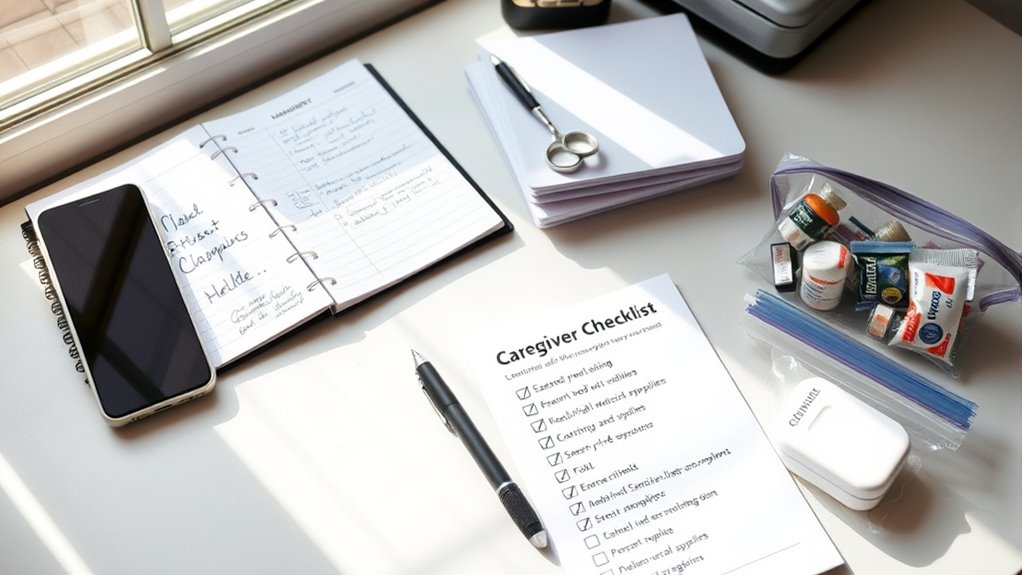
Have you gathered all the essential medical and emergency information your loved one might need in a crisis? This step is vital for a smooth caregiver vacation. First, compile their medical records, including diagnoses, medications, allergies, and recent test results. Second, update and list emergency contacts, such as family members, friends, and healthcare providers. Third, create a list of current medications with dosages and schedules to guarantee proper management. Fourth, keep a copy of their insurance details and any advance directives or legal documents. Fifth, familiarize yourself with home safety measures that can prevent accidents and facilitate quick responses in emergencies. Organize this information in a secure, easily accessible folder or digital file. Being prepared minimizes delays and confusion during emergencies, giving you peace of mind while you’re away. Clear, thorough information is your best safeguard in case of unforeseen situations.
Communicate Your Travel Plans Clearly
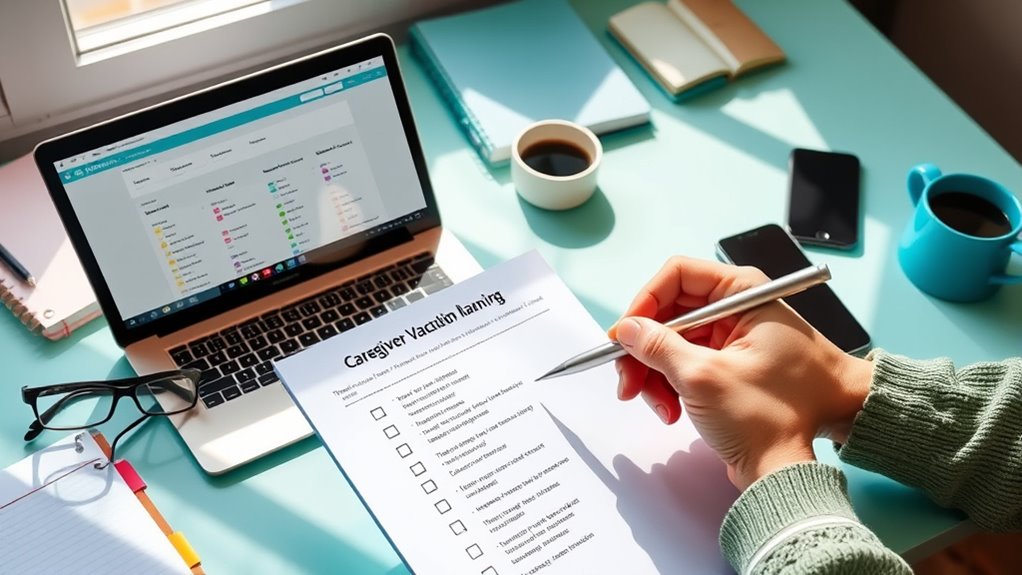
After gathering all the necessary medical and emergency information, it’s important to communicate your travel plans clearly to everyone involved in your loved one’s care. Be transparent about your schedule and establish boundaries to manage expectations. Clearly outline who will be responsible for caregiving tasks and provide contact details for emergencies. Use the following table to organize your communication:
| Caregiver | Responsibilities | Contact Info |
|---|---|---|
| Spouse | Medications, meals | (555) 123-4567 |
| Neighbor | Check-ins, errands | neighbor@email.com |
| Family | Emotional support | family@email.com |
This clarity prevents misunderstandings and reassures everyone involved. Open, honest communication guarantees your loved one’s needs are met and your vacation is stress-free. Additionally, reviewing caregiver responsibilities can help ensure all tasks are covered and nothing is overlooked.
Organize Home and Personal Care Supplies
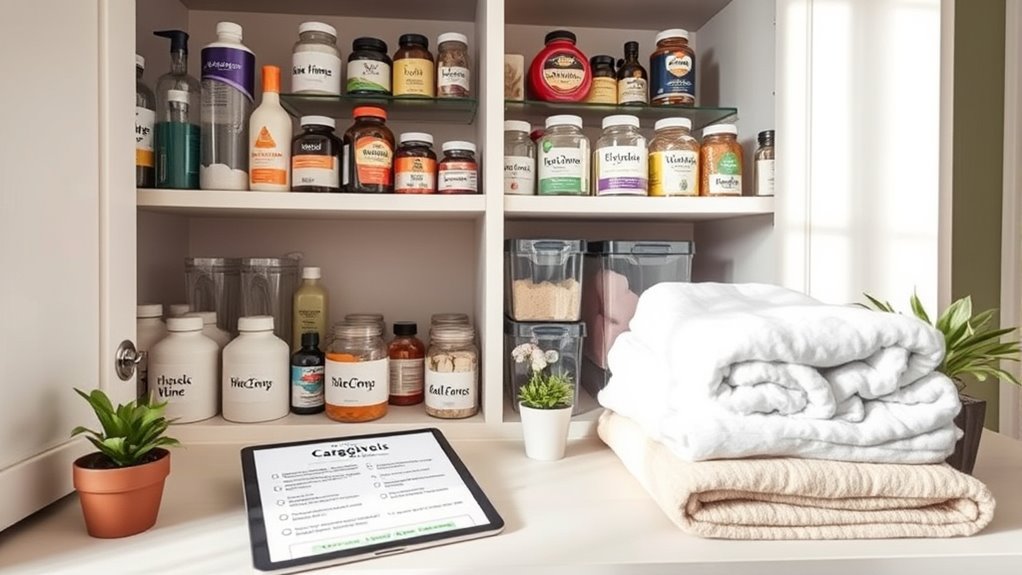
To keep your loved one comfortably cared for while you’re away, it’s essential to organize home and personal care supplies efficiently. Proper supply organization ensures medication management remains smooth and reduces confusion. Start by:
- Categorizing supplies into groups like medications, hygiene products, and daily essentials.
- Labeling containers clearly for quick access.
- Creating a designated spot for all supplies to prevent misplacement.
- Preparing an inventory list to track what’s available and what needs replenishing.
- Consider using organized storage solutions that are designed specifically for medical and personal care items, enhancing accessibility and safety.
This approach helps caregivers or family members step in easily. Make sure medications are stored safely, with doses clearly marked. Keeping supplies organized minimizes stress, ensures safety, and guarantees your loved one’s comfort during your absence.
Secure Important Documents and Medications
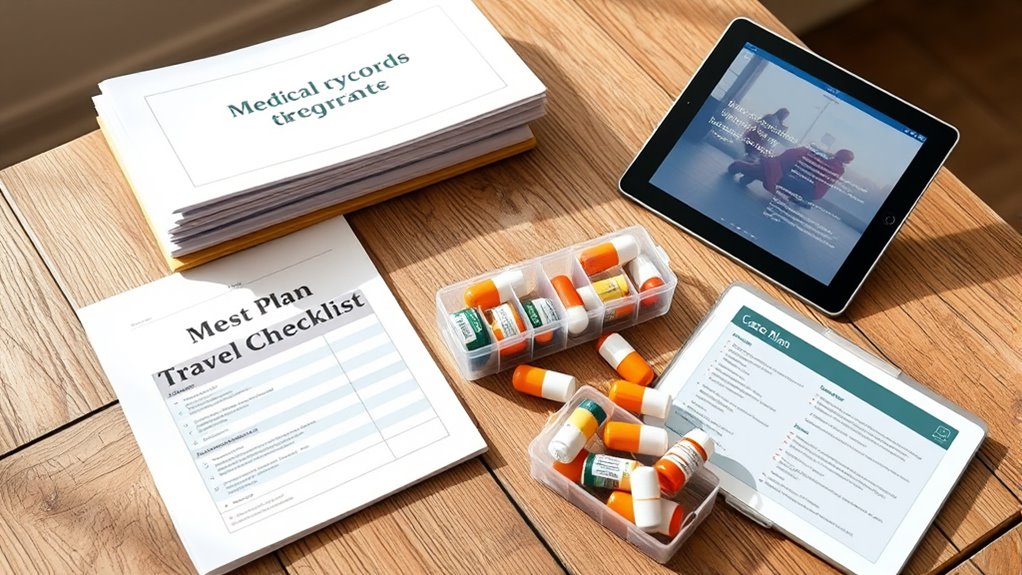
Organizing home and personal care supplies lays the groundwork for a smooth caregiving experience, but securing important documents and medications is equally essential for safety and peace of mind. Start by gathering crucial documents like medical records, insurance info, and legal papers, then store them in a secure, easily accessible location—preferably a fireproof lockbox or digital folder. For medication management, create a clear list of all medications, dosages, and schedules. Confirm medications are stored safely, away from children or pets, and that backup supplies are available if needed. Share copies of critical documents with trusted family members or caregivers. Additionally, understanding the importance of attention in maintaining organized and efficient routines can help ensure nothing is overlooked. Taking these steps minimizes disruptions during your absence and ensures your loved one’s safety and well-being remain protected.
Plan for Financial and Legal Considerations

Planning for financial and legal considerations is a crucial step to guarantee your loved one’s needs are met without unexpected hurdles. First, review insurance policies to confirm coverage is current and understand what expenses they cover. Second, update legal documentation like power of attorney and healthcare directives to reflect current wishes. Third, inform trusted family members or friends about these documents and where to find them. Fourth, consult a legal professional if needed to clarify any uncertainties or to create new documents. Confirming these legal and financial plans are in place minimizes disruptions during your absence and protects your loved one’s well-being. Additionally, understanding alimony laws can be beneficial if your loved one is involved in a divorce settlement. Taking these steps helps you leave confidently, knowing everything is organized for their ongoing care.
Make Travel and Accommodation Arrangements

You need to book transportation options that fit your schedule and budget, so consider all available choices. Securing suitable lodging is just as important—look for accommodations that are comfortable and accessible. Once these arrangements are in place, you’ll have peace of mind knowing everything is set for your trip. Additionally, ensure that your heat pump system is properly maintained to avoid unexpected breakdowns during your time away.
Booking Transportation Options
When arranging transportation for your caregiver vacation, it’s important to compare options early to find the most convenient and cost-effective choices. Start by considering these options:
- Ride sharing options like Uber or Lyft for flexible, on-demand travel.
- Local taxi services for reliable, scheduled rides.
- Public transportation such as buses or trains for budget-friendly travel.
- Car rentals if you prefer to drive yourself or explore beyond city limits.
- Be aware of surf hazards in unfamiliar areas to ensure safety during your trip.
Research each option’s prices, availability, and coverage in your destination. Booking in advance can save money and secure your preferred times. Keep contact details handy for ride sharing and taxi services. By planning ahead, you’ll ensure smooth, stress-free transportation during your caregiver vacation.
Securing Suitable Lodging
Finding suitable lodging is a key step in guaranteeing your caregiver vacation goes smoothly, especially if you want to relax and recharge. Focus on accommodations that prioritize home safety, with secure entry points, smoke detectors, and clear emergency exits. Review lodging amenities carefully to ensure they meet your needs, such as accessible bathrooms, comfortable sleeping arrangements, and reliable Wi-Fi. If you’re traveling with a loved one, choose a place that offers privacy and convenience. Consider the location’s safety and proximity to local amenities or healthcare facilities. Confirm that the lodging has necessary safety features and amenities that will make your stay comfortable. Securing the right place helps create a worry-free environment so you can truly unwind during your time away.
Develop a Communication and Emergency Plan
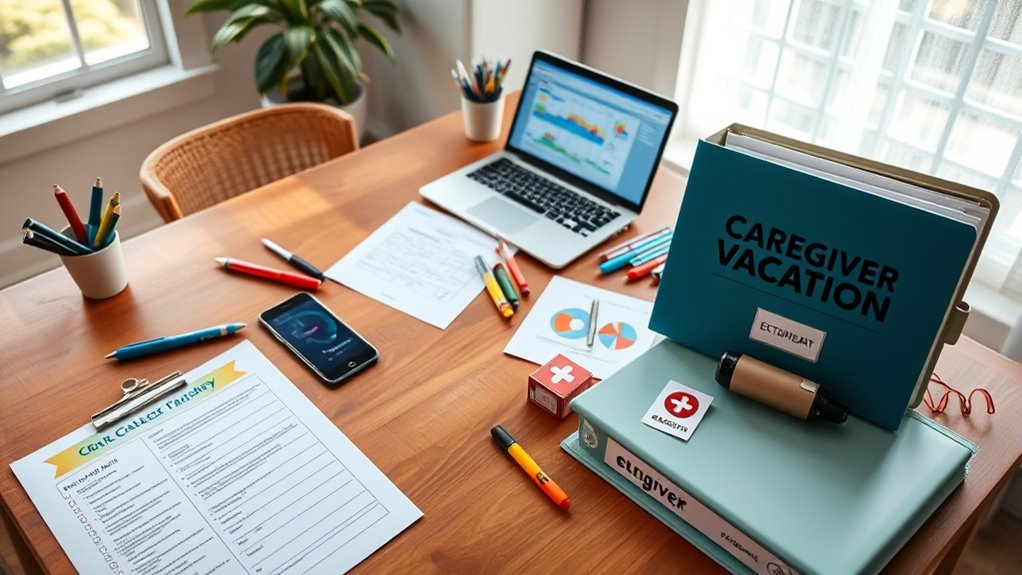
You need a solid communication and emergency plan to make certain everyone stays connected and safe. Make sure you have up-to-date emergency contact details and clear care instructions ready to share. Establish a communication schedule so caregivers can check in regularly and respond quickly if needed.
Emergency Contact Details
Have you established a clear list of emergency contacts to guarantee help is always available? Ensuring your emergency contact details are up-to-date is vital for quick response times. Follow these steps to develop a solid emergency plan:
- List primary contacts, including family, friends, and neighbors, with real-time contact information.
- Include healthcare providers and local emergency services in your contacts.
- Clearly outline emergency protocols, such as when to call 911 or notify specific individuals.
- Share this information with your caregiver and any backup persons, ensuring everyone knows how to act swiftly.
Having accurate contact information and clear emergency protocols minimizes confusion and delays during critical moments, providing peace of mind for you and your caregiver while you’re away.
Clear Care Instructions
Building on your emergency contact list, creating clear care instructions guarantees everyone knows exactly how to assist your loved one in any situation. Include detailed guidance on medication management, such as dosages, timing, and any side effects to watch for. Clearly outline hygiene routines, like bathing, oral care, and skincare, so caregivers can maintain consistency. Make sure instructions are easy to understand, with step-by-step procedures if needed. Label medications and supplies, and specify who’s responsible for each task. Keep this information in a readily accessible folder or digital file. By providing precise, thorough directions, you ensure seamless care, reduce confusion, and give your loved one the support they need, even when you’re away.
Communication Schedule
Establishing a clear communication schedule guarantees everyone stays informed and responds promptly in any situation. To do this effectively, consider these steps:
- Schedule regular virtual check-ins to discuss updates and address concerns.
- Set specific times for notifications to ensure timely communication.
- Define notification protocols, including who to contact first and alternative contacts if needed.
- Create a shared emergency plan with clear instructions for urgent situations.
Using virtual check-ins keeps everyone connected, even remotely, and helps prevent miscommunication. Establishing clear notification protocols ensures important information is relayed quickly and accurately. By planning these elements, you minimize stress during your absence and ensure your loved ones are well cared for. A solid communication schedule is a crucial part of your caregiver vacation plan.
Frequently Asked Questions
How Far in Advance Should I Start Planning My Caregiver Vacation?
You should start planning your caregiver vacation at least 2 to 3 months in advance. This gives you enough time for respite care arrangements and detailed travel planning. Early planning ensures you find reliable caregivers, secure travel bookings, and coordinate essential support. By giving yourself plenty of time, you minimize stress and ensure everything is in place, so you can truly enjoy your well-deserved break without last-minute worries.
What Are Signs a Loved One Isn’t Suitable for Backup Care?
Like a storm gathering on the horizon, signs your loved one may not be suitable for backup care become clear through behavioral changes and communication difficulties. If they become unusually withdrawn, agitated, or refuse help, it’s a red flag. You may notice confusion or difficulty expressing themselves. These signs indicate that their needs might require a more specialized approach, and backup care might not be sufficient to guarantee their safety and well-being.
How Can I Ensure My Loved One Remains Engaged During My Absence?
To keep your loved one engaged during your absence, focus on activities planning and engagement strategies tailored to their interests. You can set up daily routines, include puzzles, music, or art projects, and schedule regular check-ins. Encourage social interactions with friends or family, and consider involving them in hobbies they enjoy. By proactively creating a stimulating environment, you help verify your loved one remains active and connected while you’re away.
What Legal Considerations Should I Keep in Mind When Planning a Caregiver Break?
When planning a caregiver break, you should review legal considerations like updating legal documentation, including power of attorney and healthcare directives. Confirm confidentiality agreements are in place to protect your loved one’s privacy and sensitive information. These steps help prevent legal complications, clarify responsibilities, and ensure your loved one’s care continues smoothly. Always consult with a legal professional to verify that all documentation is current and compliant with local laws.
How Do I Handle Unexpected Emergencies While Away?
When handling unexpected emergencies while you’re away, you should first guarantee that emergency contacts are updated and easily accessible. Share safety protocols with your backup caregiver so they know how to respond quickly. Stay connected through a trusted communication plan, and consider setting up alerts or check-ins. Being prepared with clear instructions and accessible emergency information helps your loved one stay safe, even when you’re not there.
Conclusion
Planning a caregiver vacation might seem challenging, but with the right checklist, you can enjoy peace of mind. Did you know that nearly 60% of caregivers report feeling overwhelmed? Taking the time to prepare guarantees your loved one’s needs are met and your trip is stress-free. Remember, clear communication and reliable backup plans are key. So, go ahead—plan your well-deserved break and return refreshed, knowing you’ve done everything to support your loved one’s well-being.




